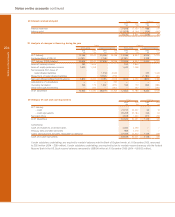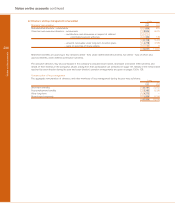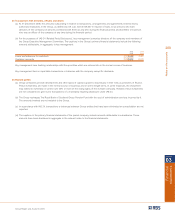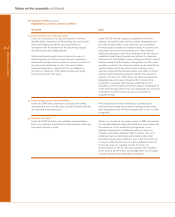RBS 2005 Annual Report Download - page 215
Download and view the complete annual report
Please find page 215 of the 2005 RBS annual report below. You can navigate through the pages in the report by either clicking on the pages listed below, or by using the keyword search tool below to find specific information within the annual report.
section
03
Financial
statements
213
Notes on the accounts
Annual Report and Accounts 2005
UK GAAP
(q) Effective interest rate and lending fees
Under UK GAAP, loan origination fees are recognised when
received unless they are charged in lieu of interest.
(r) Derivatives and hedging
Under UK GAAP non-trading derivatives are accounted for on
an accruals basis in accordance with the accounting treatment
of the underlying transaction or transactions being hedged. If
a non-trading derivative transaction is terminated or ceases to
be an effective hedge, it is re-measured at fair value and any
gain or loss amortised over the remaining life of the underlying
transaction or transactions being hedged. If a hedged item is
derecognised the related non-trading derivative is remeasured
at fair value and any gain or loss taken to the income
statement.
Embedded derivatives are not bifurcated from the host
contract.
(s) Loan impairment
Under UK GAAP provisions for bad and doubtful debts are
made so as to record impaired loans at their ultimate net
realisable value. Specific provisions are established against
individual advances or portfolios of smaller balance
homogeneous advances and the general provision covers
advances impaired at the balance sheet date but which have
not been identified as such. Interest receivable from loans and
advances is credited to the income statement as it accrues
unless there is significant doubt that it can be collected.
IFRS
IAS 39 requires the amortised cost of a financial instrument to
be calculated using the effective interest method. The effective
interest rate is the rate that discounts estimated future cash
flows over an instrument’s expected life to its net carrying
value. It takes into account all fees and points paid that are an
integral part of the yield, transaction costs and all other
premiums and discounts.
On implementation of IAS 39, the carrying value of financial
assets was reduced by £708 million and financial liabilities
increased by £224 million, deferred tax was reduced by £283
million and shareholders’ equity reduced by £649 million.
Under IAS 39, all derivatives are measured at fair value. Hedge
accounting is permitted for three types of hedge relationship:
fair value hedge – the hedge of changes in the fair value of a
recognised asset or liability or firm commitment; cash flow
hedge – the hedge of variability in cash flows from a
recognised asset or liability or a forecasted transaction; and
the hedge of a net investment in a foreign entity. In a fair value
hedge the gain or loss on the derivative is recognised in profit
or loss as it arises offset by the corresponding gain or loss on
the hedged item attributable to the risk hedged. In a cash flow
hedge and in the hedge of a net investment in a foreign entity,
the element of the derivative’s gain or loss that is an effective
hedge is recognised directly in equity. The ineffective element
is taken to the income statement. Certain conditions must be
met for a relationship to qualify for hedge accounting. These
include designation, documentation and prospective and
actual hedge effectiveness. On implementation of IAS 39, non-
trading derivatives were remeasured at fair value.
A derivative embedded in a contract is accounted for as a
stand-alone derivative if its economic characteristics are not
closely related to the economic characteristics of the host
contract, unless the entire contract is carried at fair value
through profit or loss.
IFRS require impairment losses on financial assets carried at
amortised cost to be measured as the difference between the
asset's carrying amount and the present value of estimated
future cash flows discounted at the asset's original effective
interest rate. There is no concept of specific and general
provision – under IFRS impairment is assessed individually for
individually significant assets but can be assessed collectively
for other assets. Once an impairment loss has been
recognised on a financial asset or group of financial assets,
interest income is recognised on the carrying amount using the
rate of interest at which estimated future cash flows were
discounted in measuring impairment.
























